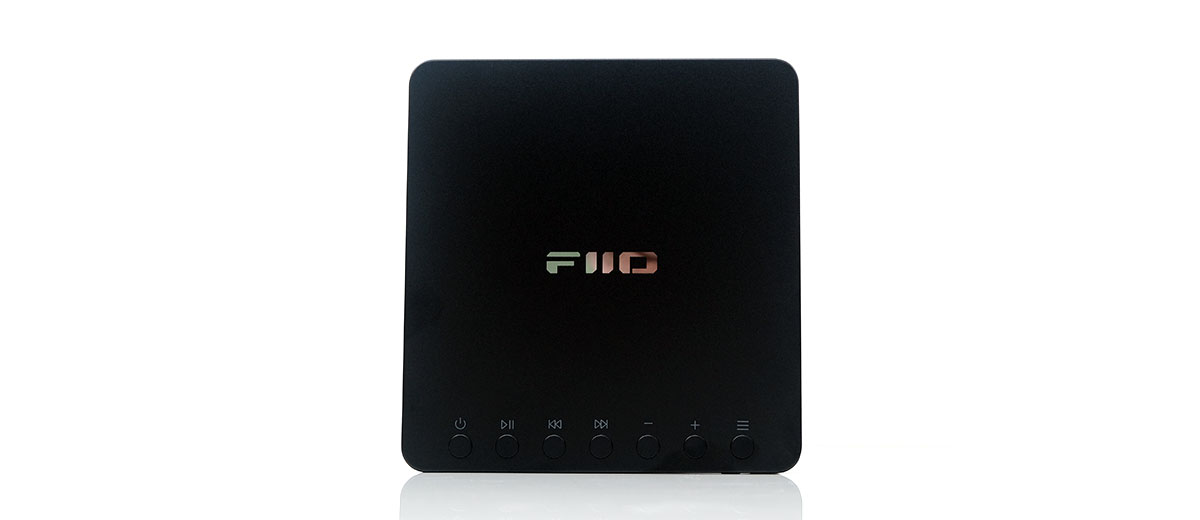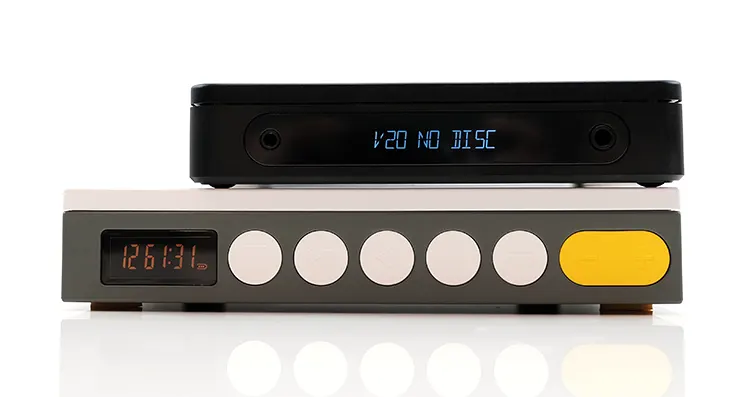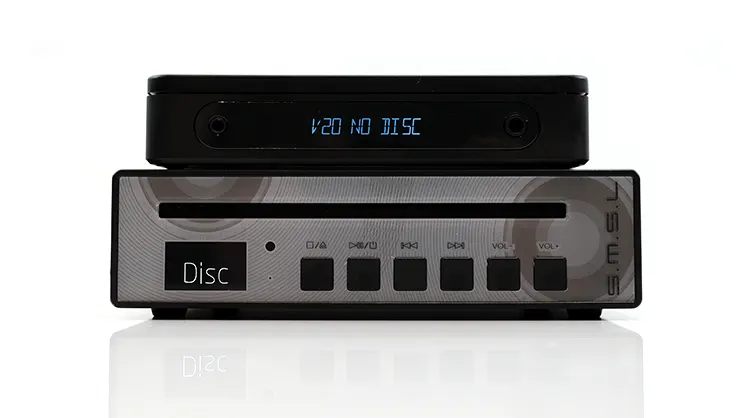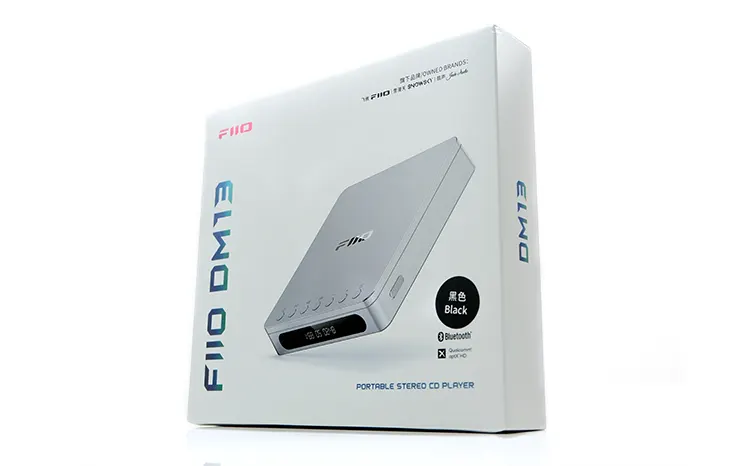Select Comparisons
The following comparisons to the DM13 were completed using a mix of Campfire Audio’s Andromeda 2020, THIEAUDIO’s Monarch MKIII, and the Audeze MM-500 headphones.
MOONDROP DISCDREAM 2
The DISCDREAM 2 was launched last year at the same time as the high-end ULTRA version and is the nearest competitor to the DM13 in terms of pricing and feature set. We will soon have a full review of the regular DISCDREAM 2 edition.
Technical
In some ways, these players share many similar traits, such as a CS DAC chipset, headphone output, a lineout, and optical output.
However, the DM13 implementation of each is more comprehensive despite its similar price point. Instead of a single CS43131 DAC chipset with single-ended output, the DM13 has a dual CS43198 with single-ended and balanced outputs.
Sticking with the headphone (PO) output capability, the DM13 is far more capable if we judge it purely on numbers at up to 660mW going balanced into a 32Ω load compared to 124mW into the same load from the DISCDREAM 2’s SE output.
Bear in mind, the DISCDREAM 2’s 124mW rating is an undistorted power rating and not a maximum but even so, it cannot compete with the DM13’s 660mW rating. It is possible its max rating on SE is closer to the DM13’s 180mW max rating on the same load.
There is no real decoding comparison to work on here for the DAC since the DM13 has no USB DAC capability. That is the DISCDREAM 2’s main advantage. If you need a USB DAC/amp the MOONDROP is the better choice.
There is also no real BT comparison since the DISCDREAM 2 does not have any wireless capability similar to the DM13.
Battery life will vary a lot more with the DM13 depending on what feature set you use but on basic CD playing and a similar PO load, both units come in at just under 10 hours.
Both players will work from a USB-C power link for charging, but only the DM13 can bypass the battery for extended playback via the D.Mode feature. The DM13 can also rip via a USB stick or directly to a PC/MAC, which the DISCDREAM 2 cannot do.
Design
Aesthetically the DISCDREAM 2 properly captures the retro vibe, standing out with its ‘cutesy’ multi-tone finish and big button layout on the front panel.
Its transparent panel is also very appealing, more so than the black DM13 unit I have here, though the alternative DM13 transparent edition would be on par.
The DISCDREAM 2 screams fun, almost looking like a toy, and is likely to be the unit that catches your eye first.
However, it’s a lot bigger than the DM13, far less portable, and made of plastic rather than aluminum. Technically, its form factor and feature flow are not that different than the more expensive Ultra version, just built with cheaper materials.
The weight therefore is not that different between the two players despite the bigger size of the DISCDREAM 2. The size, however, means the MOONDROP player is more suited to desktop use, with no lid latch compounding that lack of portability.
I prefer the DISCDREAM LCD display, though. Its orange light hue is more in keeping with its color finish, and it also has a battery display, which is lacking on the DM13.
Accessing the battery status requires an awkward button mash on the DM13, which has a number system, whereas the DISCDREAM 2 has a more familiar battery icon that is always on display.
One thing to note about the DISCDREAM 2’s CD tray, it’s not as spacious as the DM13’s. I have yet to see any scratching on either but the MOONDROP bay is a little tighter.
Performance
The DISCDREAM 2 performance is not as compelling as the Ultra version, meaning I found the DM13 a more dynamic performer, especially with its additional balanced output option.
It is probably the lack of balanced output and single DAC chipset that hampers the DISCDREAM 2’s otherwise more balanced tonal signature compared to the Andromeda 2020, my test IEM for this comparison.
Noise-wise, both do very well at low volume levels, there is no issue with hiss impacting dynamic range. Rather, it is the switch to the single DAC chipset and an SE output only that reduces the channel separation and dynamic range of the MOONDROP DISCDREAM 2 performance giving the sound a “samey tone”.
I would still argue that the MOONDROP does better in midrange and treble presence and lacks the same bass depth and weight as the DM13.
On 80s rock recordings, especially ones that can come off as a bit dry, the DM13’s juicier low-end fleshes-out bass guitar plucks a lot better and introduces superior depth for a more holographic and vibrant presentation.
The DISCDREAM 2’s reduced contrast and separation, combined with a flatter low-end, make it less competitive for the same recordings. I would prefer the DISCDREAM 2 for more intimate tracks, with vocal-centric recordings where its clearer mids can shine.
With a balanced output, the DM13 is much the better performer with headphones. I also said that in the Ultra review, and more so with the weaker output of the regular edition of the DISCDREAM 2, which lacks a more powerful balanced output.
SMSL PL100
The SMSL PL100 was recently launched at a very competitive price tag of $105.99, cheaper than the DM13. It is not technically a portable player with no battery, but its 5V/2A USB-C power supply means you can run it off a power bank just as easily as a PC or plug.
Technical
The PL100 has more in common with the DISCDREAM 2 than the DM13 but given its lower price point perhaps that is more justifiable.
The PL100 has a single CS43131 instead of a dual CS DAC chipset. Neither the DM13 nor the PL100 can operate as a USB DAC, so the decoding capability is limited to how well they can decode physical media. Only the DM13 can rip CDs and transmit wirelessly.
The PL100 also lacks the DM13’s balanced amplification and 660mW of output power. It has a single 3.5mm PO with a maximum of 60mW into a 32Ω load. Similar to its excellent bigger sibling, the PL200, the PL100’s output is on the rear panel rather than the front.
If you want to use the PL100 for head gear I would recommend IEMs and some easy-to-drive headphones only. The DM13 is your choice here if you want a good level of driving power for more demanding headphones.
If you plan on using either for a HiFi system, the PL100 has an advantage via traditional connection ports for its digital (optical and coaxial) and analog (dual RCA) outputs. This is an understandable advantage, given that it is designed to be a desktop component rather than a portable player.
However, I suspect the biggest talking point of the PL100 might be the slot-loading mechanism as opposed to the DM13’s traditional portable player top-loading method.
So far I have not had any rejection issues with the PL100 but I am always cautious with slider trays in case they fail to read or accidentally scratch discs on insertion.
Design
The PL100 looks every bit like a stolen PC CD component drive and ‘tarted it up’ with a nice button array and a decent LED screen on the front panel.
There is nothing unique about the PL100 form factor though with a degree of irony its ultra-boxy design might remind some of the mid-90s HiFi design language.
The PL100 comes with a remote control, which I wouldn’t expect at this price point, even though it is a desktop player at heart. This makes life easier if you are operating it as part of a couch-based HiFi system.
Though the DM13 black edition is rather subdued in its aesthetic appeal the smoother cornering, smaller form factor and lighter weight make it a very portable and easy-to-handle player. The PL100 betrays its desktop pitch being over twice the weight of the DM13.
You can carry the PL100 in a bag, plug it into a power bank, and run it just fine. However, at best this is transportability than true portability with no mention of ESP for the PL100 to protect it against shocks.
With D.Mode you can use the DM13 as part of a HiFi system, similar to the PL100. However, the proper port connections on the rear panel of the PL100 make it more ‘plug and play’ compared to the various conversion cable requirements on the back of the FiiO player.
Performance
With an IEM such as the THIEAUDIO Monarch MKIII and using a single-ended output, the contrast between the PL100 and the DM13 mirrors that of the Ultra comparison.
The DM13 is richer, weightier, and smoother sounding but lacks the midrange presence and clarity of the PL100’s equivalent presentation. If you want vocal clarity and a bit more treble presence then the PL100 is a good choice.
However, the PL100 is not quite as flat in the lows as the Ultra or the regular edition DISCDREAM 2, though the DM13 is still the most powerful player on the lows by some distance with any gear I tested it with.
The PL100 has more about its lower mids and upper bass compared to the MOONDROP tuning and that injects more pleasing saturation into the instrumental timbre.
I found the treble on the PL100 to be more or less neutral to ever-so-slightly bright, not by a huge amount. With EST drivers, I could hear a bit more sibilance in percussion timbre compared to the DM13, but bear in mind that the DM13 is more attenuated in the treble, so that is a comparative observation.
Where the DM13 pulls ahead of the PL100 is when you switch to its balanced output.
It offers a much more holographic performance, a firmer impact on percussion timbre, and better channel separation. I also detected an improved level of textured detail in the notes, whereas the PL100 sounded comparatively pristine and polished on those same notes.
The final observation is headphone playback. It is no surprise that the DM13 outperforms the PL100 with more power, improved headroom, superior depth, and dynamic range. The PL100 is not built to drive headphones with its 3.5mm 60mW output (32Ω).
My Verdict
Whilst I am not wholly in love with the DM13 sound signature I have to tip my cap to FiiO for cramming a ton of useful features and loads of power into a relatively affordable portable CD player.
You have to upgrade to the DISCDREAM Ultra and the Shanling EC Mini to get anything near the options available on the DM13.
It is also probably the most portable of all the new CD players out there, both in terms of ESP protection, size, and ease of use. I think that is an important aspect to mention.
And yet, the DM13 can function just fine as part of your HiFi system with its D.Mode power system. I recommend using it as a transport if you have a good DAC.
The analog output is okay on its own, but when magnified to a full home system, the smooth sound can mask some of the finer details I would expect to get from a dedicated DAC. The inclusion of a USB-DAC feature would have been ideal, too, but honestly, its strength is as a transport or standalone portable player.
Otherwise, pick the FiiO DM13 if you want a solid mix of portable and home-based CD player capability. It delivers a weighty and powerful warmish tone that is easy on the ear, rips CDs should you need it on the side, and with D.Mode you can prolong battery life which is a big bonus for me.
FiiO DM13 Technical Specifications
- Headphone Outputs 3.5mm Single-ended & 4.4mm Balanced
- Analogue Line-Out Yes
- SPDIF Digital Output Yes
- USB Audio Output Yes
- ESP Switch (Electronic Shock Protection) Yes
- Desktop Mode Yes
- Bluetooth Codecs: aptX HD, aptX LL, aptX, SBC (Bluetooth version only)
- Output Power: 180mW+180mW (32Ω, single-ended); 660mW+660mW (32Ω, balanced)
- Battery: 3750mAh, 10-hour playback time
- Supported Formats: CD-R with FLAC, WAV, WMA, AAC, MP3
- Dimensions: 144×137×27mm (excluding feet)
- Weight: Approximately 450g





